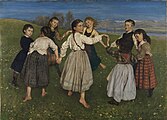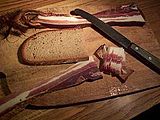Black Forest
| Black Forest | |
|---|---|
 View from the Hohfelsen nearSeebach | |
| Highest point | |
| Coordinates | 48°18′00″N8°09′00″E/ 48.300°N 8.150°E |
| Dimensions | |
| Length | 160 km (99 mi) |
| Area | 6,000 km2(2,300 sq mi) |
| Geography | |
| Country | Germany |
| State | Baden-Württemberg |
| Parent range | Southwest German Uplands/Scarplands |
| Geology | |
| Orogeny | Central Uplands |
| Type of rock | Gneiss,Bunter sandstone |
TheBlack Forest(German:Schwarzwald[ˈʃvaʁt͡svalt]) is a largeforestedmountain rangein thestateofBaden-Württembergin southwestGermany,bounded by theRhine Valleyto the west and south and close to the borders withFranceandSwitzerland.[1]It is the source of theDanubeandNeckarrivers.
Its highest peak is theFeldbergwith anelevationof 1,493 metres (4,898 ft) abovesea level.Roughly oblong in shape, with a length of 160 kilometres (100 miles) and breadth of up to 50 km (30 mi),[2]it has an area of about 6,009 km2(2,320 sq mi).[1]
Historically, the area was known for forestry and the mining oforedeposits, but tourism has now become the primary industry, accounting for around 300,000 jobs.[3]There areseveral ruined military fortificationsdating back to the 17th century.[4]
History[edit]



In ancient times, the Black Forest was known asAbnoba mons,after the Celtic deity,Abnoba.In Roman times (Late antiquity), it was given the nameSilva Marciana( "Marcynian Forest", from the Germanic wordmarka= "border" ).[5]The Black Forest probably represented the border area of theMarcomanni( "border people" ) who were settled east of the Romanlimes.They, in turn, were part of the Germanic tribe ofSuebi,who subsequently gave their name to the historic state ofSwabia.With the exception of Roman settlements on the perimeter (e.g. the baths in Badenweiler, and mines near Badenweiler and Sulzburg) and the construction of the Roman road ofKinzigtalstraße,the colonization of the Black Forest was not carried out by the Romans but by theAlemanni.They settled and first colonized the valleys, crossing the old settlement boundary, the so-called "red sandstone border", for example, from the region ofBaar.Soon afterwards, increasingly higher areas and adjacent forests were colonized, so that by the end of the 10th century, the first settlements could be found in the red (bunter) sandstone region. These include, for example,Rötenbach,which was first mentioned in 819.
Some of the uprisings (including theBundschuh movement) that preceded the 16th centuryGerman Peasants' War,originated in the Black Forest. Further peasant unrest, in the shape of thesaltpetreuprisings, took place over the next two centuries inHotzenwald.
Remnants ofmilitary fortificationsdating from the 17th and 18th centuries can be found in the Black Forest, especially on the mountain passes. Examples include the multiple baroque fieldworks ofMargraveLouis William of Baden-Badenor individual defensive positions such as theAlexanderschanze(Alexander's Redoubt), theRöschenschanzeand theSchwedenschanze(Swedish Redoubt).[6][7]
Originally,the Black Forest was a mixed forestof deciduous trees and firs. At the higher elevationssprucealso grew. In the middle of the 19th century, the Black Forest was almost completely deforested by intensive forestry and was subsequently replanted, mostly with sprucemonocultures.
In 1990, extensive damage to the forest was caused by aseries of windstorms.[a]On 26 December 1999,Cyclone Lotharraged across the Black Forest and caused even greater damage, especially to the spruce monocultures. As had happened following the 1990 storms, large quantities of fallen logs were kept in provisional wet-storage areas for years. The effects of the storm are demonstrated by theLothar Path,a forest educational and adventure trail at the nature centre inRuhesteinon a highland timber forest of about 10 hectares that was destroyed by a hurricane. Several areas of storm damage, both large and small, were left to nature and have developed today into a natural mixed forest again.
Geography[edit]

The Black Forest stretches from theHigh Rhinein the south to theKraichgauin the north. In the west it is bounded by theUpper Rhine Plain(which, from a natural region perspective, also includes the low chain of foothills); in the east it transitions to theGäu,Baarand hill country west of theKlettgau.From north to south, the Black Forest extends for over 160 km (100 mi), attaining a width of up to 50 km (30 mi) in the south and 30 km (20 mi) in the north.[8]The Black Forest is the highest part of theSouth German Scarplands,and much of it is densely wooded, a fragment of theHercynian Forestof antiquity.
Administratively, the Black Forest belongs completely to the state of Baden-Württemberg and comprises the cities ofFreiburg,PforzheimandBaden-Badenas well as the following districts (Kreise). In the north:Enz,RastattandCalw;in the middle:Freudenstadt,OrtenaukreisandRottweil;in the south:Emmendingen,Schwarzwald-Baar,Breisgau-Hochschwarzwald,LörrachandWaldshut.
Natural regions[edit]
Thenatural regionsof the Black Forest are separated by various features.
Geomorphologically,the main division is between the gentle eastern slopes with their mostly rounded hills and broad plateaux (so-calledDanubianrelief,especially prominent in the north and east on the Bunter Sandstone) and the deeply incised, steeply falling terrain in the west that drops into theUpper Rhine Graben;the so-called Valley Black Forest (Talschwarzwald) with itsRhenanianrelief. It is here, in the west, where the highest mountains and the greatest local differences in height (of up to 1000 metres) are found. The valleys are often narrow and ravine-like. The summits are rounded, and there are remnants of plateaux andarête-like landforms.
Geologically the clearest division is also between east and west. Large areas of the eastern Black Forest, the lowest layer of theSouth German Scarplandscomposed of Bunter Sandstone, are covered by seemingly endless coniferous forest with their island clearings. The exposed basement in the west, predominantly made up ofmetamorphic rocksandgranites,was, despite its rugged topography, easier to settle and appears much more open and inviting today with its varied meadow valleys.

The most common way of dividing the regions of the Black Forest is, however, from north to south. Until the 1930s, the Black Forest was divided into the Northern and Southern Black Forest, the boundary being theline of the Kinzig valley.Later the Black Forest was divided into the heavily forestedNorthern Black Forest,the lower, central section, predominantly used for agriculture in the valleys, was theCentral Black Forestand the much higherSouthern Black Forestwith its distinctive highland economy andice ageglacial relief. The termHigh Black Forestreferred to the highest areas of the South and southern Central Black Forest.
The boundaries drawn were, however, quite varied. In 1931, Robert Gradmann called the Central Black Forest the catchment area of the Kinzig and in the west the section up to the lowerElzand Kinzig tributary of theGutach.[9]A pragmatic division, which is oriented not just on natural and cultural regions, uses the most important transverse valleys. Based on that, the Central Black Forest is bounded by the Kinzig in the north and the line fromDreisamtoGutachin the south, corresponding to theBonndorf Grabenzone and the course of the present dayB 31.
In 1959, Rudolf Metz combined the earlier divisions and proposed a modified tripartite division, which combined natural and cultural regional approaches and was widely used.[10]His Central Black Forest is bounded in the north by thewatershedbetween theAcherandRenchand subsequently between theMurgandKinzigor Forbach and Kinzig, in the south by the Bonndorf Graben zone, which restricts the Black Forest in the east as does the Freudenstadt Graben further north by its transition into the Northern Black Forest.[11]
Work of the Institute of Applied Geography[edit]
TheHandbook of the Natural Region Divisions of Germanypublished by the Federal Office of Regional Geography (Bundesanstalt für Landeskunde) since the early 1950s names the Black Forest as one of six tertiary-level major landscape regions within the secondary-level region of the South German Scarplands and, at the same time, one of nine new major landscape unit groups. It is divided into six so-called major units (level 4 landscapes).[12]This division was refined and modified in several successor publications (1:200,000 individual map sheets) up to 1967, each covering individual sections of the map. The mountain range was also divided into three regions. The northern boundary of the Central Black Forest in this classification runs south of the Rench Valley and theKniebisto near Freudenstadt. Its southern boundary varied with each edition.[13]
In 1998, the Baden-Württemberg State Department for Environmental Protection (today the Baden-Württemberg State Department for the Environment, Survey and Nature Conservation) published a reworked Natural Region Division of Baden-Württemberg.[14]It is restricted to the level of the natural regional major units and has been used since for the state's administration of nature conservation:[15]
| No. | Natural region | Area in km2 |
Population | Pop./km2 | Settlement area in % |
Open land in % |
Forest in % |
Major centres of population |
Middle-sized centres of population |
|---|---|---|---|---|---|---|---|---|---|
| 150 | Black Forest Foothills[16] | 930 | 268,000 | 289 | 7.69 | 29.33 | 62.92 | Pforzheim | Calw, Freudenstadt |
| 151 | Black Forest Grinden and Enz Hills[17] | 699 | 60,000 | 86 | 1.92 | 6.39 | 91.51 | ||
| 152 | Northern Black Forest Valleys[18] | 562 | 107,000 | 190 | 4.12 | 19.48 | 76.41 | Baden-Baden, Gaggenau/Gernsbach | |
| 153 | Central Black Forest[19] | 1,422 | 188,000 | 133 | 3.35 | 30.25 | 66.39 | Haslach/Hausach/Wolfach, Waldkirch,Schramberg | |
| 154 | Southeastern Black Forest[20] | 558 | 80,923 | 112 | 3.03 | 32.44 | 64.49 | Villingen-Schwenningen | |
| 155 | High Black Forest[21] | 1,990 | 213,000 | 107 | 2.44 | 26.93 | 70.31 | Schopfheim, Titisee-Neustadt |

The Black Forest Foothills (Schwarzwald-Randplatten,150) geomorphologically form plateaux on the north and northeast periphery of the mountain range that descend to theKraichgauin the north and theHeckengäulandscapes in the east. They are incised by valleys, especially those of theNagoldriver system, into individualinterfluves;a narrow northwestern finger extends to beyond theEnznearNeuenbürgand also borders the middle reaches of theAlbto the west as far as a point immediately aboveEttlingen.To the southwest it is adjoined by the Black ForestGrindenand Enz Hills (Grindenschwarzwald und Enzhöhen,151), along the upper reaches of the Enz and Murg, forming the heart of the Northern Black Forest. The west of the Northern Black Forest is formed by the Northern Black Forest Valleys (Nördliche Talschwarzwald,152) with the middle reaches of the Murg aroundGernsbach,the middle course of theOostoBaden-Baden,the middle reaches of theBühlotaboveBühlsand the upper reaches of theRencharoundOppenau.Their exit valleys from the mountain range are all oriented towards the northwest.
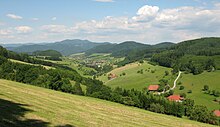
The Central Black Forest (153) is mainly restricted to thecatchment areaof the RiverKinzigaboveOffenburgas well as theSchutterand the low hills north of theElz.
The Southeastern Black Forest (Südöstliche Schwarzwald,154) consists mainly of the catchment areas of the upper reaches of theDanubeheadstreams, theBrigachandBregas well as the left side valleys of theWutachnorth ofNeustadt– and thus draining from the northeast of the Southern Black Forest. To the south and west it is adjoined by the High Black Forest (Hochschwarzwald,155) with the highest summits in the whole range around theFeldbergand theBelchen.Its eastern part, the Southern Black Forest Plateau, is oriented towards the Danube, but drained over the Wutach and theAlbinto the Rhine. The southern crest of the Black Forest in the west is deeply incised by the Rhine into numerous ridges. Immediately right of theWieseaboveLörrachrises the relatively small Bunter Sandstone-Rotliegendestable of the Weintenau Uplands (Weitenauer Bergland) in the extreme southwest of the Black Forest; morphologically, geologically and climatically it is separate from the other parts of the Southern Black Forest and, in this classification, is also counted as part of the High Black Forest.

Mountains[edit]
At1,493 m abovesea level (NHN)theFeldbergin the Southern Black Forest is the range's highest summit. Also in the same area are theHerzogenhorn(1,415 m) and theBelchen(1,414 m). In general the mountains of the Southern or High Black Forest are higher than those in the Northern Black Forest. The highest Black Forest peak north of the Freiburg–Höllental–Neustadt line is theKandel(1,241.4 m). Like the highest point of the Northern Black Forest, theHornisgrinde(1,163 m), or the Southern Black Forest lookout mountains, theSchauinsland(1,284.4 m) andBlauen(1,164.7 m[22]) it lies near the western rim of the range.
Rivers and lakes[edit]
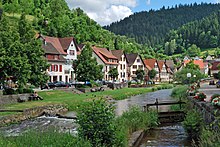
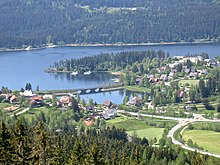
Rivers in the Black Forest include theDanube(which originates in the Black Forest as the confluence of theBrigachandBregrivers), theEnz,theKinzig,theMurg,theNagold,theNeckar,theRench,and theWiese.The Black Forest occupies part of thecontinental dividebetween theAtlantic Oceandrainage basin(drained by theRhine) and theBlack Seadrainage basin (drained by the Danube).
The longest Black Forest rivers are (length includes stretches outside the Black Forest):
- Enz(105 kilometres; 65 mi)
- Kinzig(93 kilometres; 58 mi)
- Elz(90 kilometres; 56 mi)
- Wutach(91 kilometres; 57 mi)
- Nagold(90 kilometres; 56 mi), hydrological main artery of the Nagold-Enz systems
- Danube(86 kilometres; 53 mi),headstreams:
- Murg(79 kilometres; 49 mi)
- Rench(57 kilometres; 35 mi)
- Schutter(56 kilometres; 35 mi)
- Wiese(55 kilometres; 34 mi)
- Acher(54 kilometres; 34 mi)
- Dreisam(incl.Rotbach49 kilometres; 30 mi)
- Alb(incl.Menzenschwander Alb43 kilometres; 27 mi)
- Glatt(37 kilometres; 23 mi)
- Möhlin(32 kilometres; 20 mi)
- Wolf(31 kilometres; 19 mi)
- Schiltach(30 kilometres; 19 mi)
- Wehra(incl. Rüttebach 28 kilometres; 17 mi)
- Oos(25 kilometres; 16 mi)
- Glasbach(18 kilometres; 11 mi), hydrological main artery of theNeckarsystem
Important lakes of natural,glacialorigin in the Black Forest include theTitisee,theMummelseeand theFeldsee.Especially in the Northern Black Forest are a number of other, smallertarns.Numerousreservoirslike the – formerly natural but much smaller –Schluchseewith the other lakes of theSchluchseewerk,theSchwarzenbach Reservoir,theKleine Kinzig Reservoiror theNagold Reservoirare used forelectricity generation,flood protectionordrinking watersupply.
Geology[edit]
This articleneeds additional citations forverification.(November 2017) |
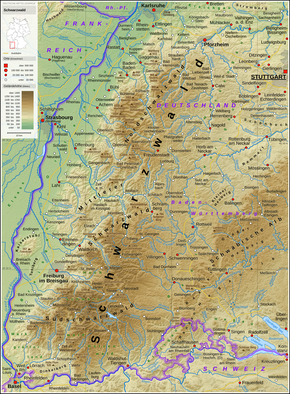
The Black Forest consists of a cover ofsandstoneon top of a core ofgneissandgranite.Formerly it shared tectonic evolution with the nearbyVosges Mountains.Later during the MiddleEoceneariftingperiod affected the area and caused formation of theUpper Rhine Plain.During the lastglacial periodof theWürm glaciation,the Black Forest was covered by glaciers; severaltarns (or lakes)such as theMummelseeare remains of this period.
Basement[edit]
The geological foundation of the Black Forest is formed by the crystalline bedrock of theVariscanbasement. This is covered in the east and northeast byBunter Sandstoneslabs, the so-called platforms. On the western edge a descending,step-fault-like, foothill zone borders the Upper Rhine Graben consisting of rocks of theTriassicandJurassicperiods.
The dominant rocks of the basement are gneiss (ortho- and paragneisses, in the south alsomigmatitesand diatexites, for example on the Schauinsland and Kandel). These gneisses were penetrated by a number of granitic bodies during theCarboniferousperiod. Among the bigger ones are the Triberg Granite and theForbach Granite,the youngest is the Bärhalde Granite. In the south lies the zone of Badenweiler-Lenzkirch, in which Palaeozoic rocks have been preserved (volcanite and sedimentary rocks), which are interpreted as the intercalated remains of amicrocontinentalcollision. Still further in the southeast (around Todtmoos) is a range of exotic inclusions:gabbrofromEhrsberg,serpentinitesandpyroxenitesnear Todtmoos,noritenearHorbach), which are possibly the remnants of anaccretionary wedgefrom a continental collision. Also noteworthy are the basins in theRotliegend,for example the Schramberg or the Baden-Baden Basin with thick quartz-porphyry andtuffplates (exposed, for example, on the rock massif ofBattertnear Baden-Baden). Thickrotliegendesrock, covered by bunter, also occurs in the north of theDinkelbergblock (several hundred metres thick in the Baselgeothermalborehole). Even further to the southeast, under the Jura, lies the North Swiss Permocarboniferous Basin.
Uplift of the mountains[edit]
Since the downfaulting of theUpper Rhine Grabenduring theEoceneepoch, the two shoulders on either side have been uplifted: the Black Forest to the east and theVosgesto the west. In the centre lies theKaiserstuhl volcano,which dates to theMiocene.In the times that followed, theMesozoicplatformon the uplands was largely eroded, apart from remains of Bunter Sandstone andRotliegend Group,but it has survived within the graben itself. During thePliocenea pronounced but uneven bulge especially affected the southern Black Forest, including the Feldberg. As a result, the upper surface of the basement in the northern part of the forest around the Hornisgrinde is considerably lower. In the central Black Forest, the tectonicsynclineof the Kinzig and Murg emerged.
GeomorphologistWalther Penckregarded the Black Forest as an upliftedgeologic domeand modeled his theory ofpiedmonttreppen(piedmont benchlands) on it.[23][24]
Platform[edit]
Above the crystalline basement of the Northern Black Forest and the adjacent parts of the Central Black Forest, the bunter sandstone platforms rise in prominent steps. The most resistant surface strata on the stepped terrain of thegrindenuplands and the heights around the upper reaches of theEnz,which have been heavily eroded by the tributaries of the Murg, is the silicified main conglomerate (Middle Bunter). To the east and north are thenappesof the Upper Bunter (platten sandstones and red clays). South of the Kinzig the Bunter Sandstone zone narrows to a fringe in the east of the mountain range.
Ice age and topography[edit]
It is considered proven that the Black Forest was heavily glaciated during the peak periods of at least theRissandWürmglaciations (up to about 10,000 years ago). This glacial geomorphology characterizes almost all of the High Black Forest as well as the main ridge of the Northern Black Forest. Apart from that, it is only discernible from a large number ofcirquesmainly facing northeast. Especially in this direction snow accumulated on the shaded and leeward slopes of the summit plateau to form short cirque glaciers that made the sides of these funnel-shaped depressions. There are still tarns in some of these old cirques, partly a result of theanthropogenicelevation of the low-side lip of the cirque, such as theMummelsee,Wildsee,Schurmsee,Glaswaldsee,Buhlbachsee,Nonnenmattweiher,andFeldsee.The Titisee formed asglacial lakebehind a glacialmoraine.
Culture[edit]
The Black Forest is mainly rural, with many scattered villages and a few large towns. Tradition and custom are celebrated in many places in the form of annual festivities. The main dialect spoken in the Black Forest area isAlemannic.The forest is best known for itstypical farmhouseswith their sweepinghalf-hipped roofs,itsBlack Forest gâteaus,Black Forest ham,Black Forestgnomes,[25][26]Kirschwasserand thecuckoo clock.
Traditional costume[edit]
Traditional costume orTrachtis still sometimes worn today, usually at festive occasions. The appearance of such costume varies from region to region, sometimes markedly. One of the best-known Black Forest costumes is that of the villages ofKirnbach,ReichenbachandGutach im Kinzigtalwith the characteristicBollenhutheaddress. Unmarried women wear the hats with red bobbles orBollen;married women wear black. Engaged women sometimes wear abridal crown(Schäppel) before and on the day of their wedding,[27][28]whose largest examples from the town ofSt. Georgenweigh up to 5 kilograms.
-
Traditionally, theBollenhutis worn by unmarried women as part of thetracht.
Art[edit]
Its rural beauty as well as the sense of tradition of its inhabitants attracted many artists in the 19th and early 20th centuries, whose works made the Black Forest famous the world over. Notable wereHans ThomafromBernauand his fellow student, Rudolf Epp, who was sponsored by the Grand Duke of Baden,Frederick I.Both artists painted motifs from the Black Forest throughout their lives. ArtistJ. MetzlerfromDüsseldorftravelled through the Black Forest to paint his landscapes. The works of the Gutach artist colony aroundWilhelm Hasemannwere widely admired, their landscape and genre motifs capturing the character of the Black Forest. Like local author Heinrich Hansjakob, they were part of a Baden folk costume movement.[29]
- Art gallery
-
Arnold Lyongrün:Frühling im Schwarzwald(1912)
-
Kinderreigen(1872) by Black Forest artistHans Thoma
-
Black Forest landscape byJ. Metzler
-
Black Forest landscape byJ. Metzler
-
Black Forest farmhouse, painted byWilhelm Hasemann
-
A Gutach family, painted byWilhelm Hasemann(c. .1900)
Crafts[edit]

In the field of handicrafts,wood carvingproduces folk art like theLonginus crossesalong with sculptors likeMatthias Faller.Wood carving is a traditional cottage industry in the region, and carved ornaments now are produced in substantial numbers as souvenirs for tourists.Cuckoo clocksare a popular example.
Glassblowingis another notable craft of the Black Forest region.[30]At the beginning of the 15th century, the art of glassmaking took hold in the Bavarian-Bohemian border mountains, especially since the necessary raw materials such asquartzandwoodwere abundant here. With the permission of the manor, glassblowers operated simple glass production facilities as "wandering huts" (Wanderhütten), the locations of which were relocated when the local resources were available. They needed huge amounts of firewood and wood forpotash.In the second half of the 18th century, the huts had to close due to a shortage of wood and sales difficulties. Only after 1800, when the demand for luxury glass increased enormously, when a few decades of regulated forestry had ensured the regrowth of the raw material wood and when the forest-destroying potash extraction had become unnecessary due to the new glass flux soda, some glass huts (Glashütten) revived.[31]Some glassblowing factories still testify to this today, for example inHöllental,nearTodtnauand inWolfach.[32]
Cuisine[edit]
Black Forest hamoriginated from this region, as did theBlack Forest gâteau,which is also known as "Black Forest Cherry Cake" or "Black Forest Cake" and is made with chocolate cake, cream, sour cherries andKirsch.[33]The Black Forest variety ofFlammekuecheis a Baden specialty made with ham, cheese and cream.Pfannkuchen,acrêpeor crêpe-like (EierkuchenorPalatschinken) pastry, is also common.
The Black Forest is known for its long tradition in gourmet cuisine. No fewer than 17Michelin starredrestaurants are located in the region, among them two restaurants with three stars (Restaurants Bareiss andSchwarzwaldstubeinBaiersbronn)[34]as well as the only restaurant in Germany that has been awarded a Michelin star every year since 1966. AtSchwarzwald Hotel AdlerinHäusern,three generations of chefs from the same family have defended the award from the first year the Michelin Guide selected restaurants in Germany until today.[35]
- Cuisine gallery
-
Black Forest ham with German bread
-
A Black Forest cake
-
Slice of a Black Forest Cake
Fasnet[edit]
The German holiday ofFastnacht,orFasnet,as it is known in the Black Forest region, occurs in the time leading up toLent.OnFasnetmendig,or the Monday beforeAsh Wednesday,crowds of people line the streets, wearing wooden, mostly hand-carved masks.[36]One prominent style of mask is called the Black Forest Style, originating from the Black Forest Region.
- Fastnacht gallery
-
Fastnacht in the Black Forest
-
Carnival pleasure in the Black Forest (1890)
-
Fastnacht inGernsbach(Black Forest)
Cego[edit]

The Black Forest is home to an unusualtarot card gamecalledCego,that is part of the region's cultural heritage.[37]After the defeat ofFurther Austriain 1805, much of its territory was allocated to theGrand Duchy of Baden.During the ensuingNapoleonic Wars,soldiers from Baden deployed with Napoleon's troops to Spain where, among other things, they learned a new card game,Ombre.They took this back to Baden and adapted it to be played withTarotcards which were then in common use in southern Germany.[38]
Cego soon developed into the national game of Baden andHohenzollern,and these are the only regions of Germany where tarot cards are still used for playing games.[39]The game has grown organically, and there are many regional variations, but in recent years the establishment of a Cego Black Forest Championship has led to official tournament rules being defined.[38][37]In addition, regular courses and local tournaments are held and it is a permanent feature ofAlemannicWeek, held annually in the Black Forest at the end of September.[40]
Nature[edit]
Conservation areas[edit]

There are twonature parksand onenational parknamed after the Black Forest that cover the region: theSouthern Black Forest Nature Park,theCentral/North Black Forestand theBlack Forest National Park.The difference between a nature park and a national park is that a nature park's aim is to strive for environmentally sustainableland use,to preserve the countryside as a cultural landscape, to market local produce more effectively, to make the area more suitable forsustainable tourismand to practiceenvironmental education.[41]A national park's aims are to protect the country's natural heritage, to practice environmental education, to serve purposes of scientific environmental observation and to prevent the area from being commercially exploited.[42]
TheSouthern Black Forest Nature Park(Naturpark Südschwarzwald) was founded in 1999. It comprises 394,000haand is therefore Germany's largest nature park (as of 2020). It encloses the southern part of the Central Black Forest, the Southern Black Forest and adjacent areas.[43]
TheCentral/North Black Forest Nature Park(Naturpark Schwarzwald Mitte/Nord) was founded in 2000. It covers 375,000 ha and is thus the second-largest in Germany (as of 2020). It begins in the southern part of the Central Black Forest, bordering on the Southern Black Forest Nature Park and covers the rest of the Black Forest to the north.[44]
TheBlack Forest National Park,established in 2014, is the firstnational parkin Baden-Württemberg. It lies completely within theCentral/North Black Forest Nature Parkbetween the cities ofFreudenstadtandBaden-Badenand covers an area of 10,062 ha. Its motto is "Natur Natur sein lassen" (let nature be nature).[45]
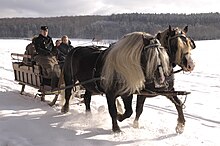
Fauna[edit]
In addition to the characteristic range of fauna found in Central European forests, the following less common animals may be observed in the Black Forest:[46]
- Black Forest cattlewhich belong to the rare breed ofHinterwälder cattle,[47]
- the giant earthwormLumbricus badensis,which is found only in the Black Forest region,[48]
- theBlack Forest Horse,adraft horseonce indispensable for heavy field work and nowadays an endangered breed,[49]and
- the endangeredWestern capercaillie.[50]
Climate[edit]
The mountain range has lower temperatures and higher rainfall than its surrounding countryside. The highlands of the Black Forest are characterized by regular rainfall throughout the year. However, temperatures do not fall evenly with increasing elevation, nor does the rainfall increase uniformly. Rather, the precipitation rises quickly even in the lower regions and is disproportionately heavy on the rainier western side of the mountains.

The wettest areas are the highlands around the Hornisgrinde in the north and around the Belchen and Feldberg in the south, where annual rainfall reaches 1,800–2,100 mm.[51]Moisture-laden Atlantic westerlies dump about as much rain in the Northern Black Forest, despite its lower elevation, than in the higher area of the Southern Black Forest.[52]There, the Vosges act as a rain shield in the face of the prevailing winds. On the exposed east side of the Central Black Forest, it is much drier; the annual rainfall there is about 750 L/m2.
The higher elevations of the Black Forest are characterized by relatively small annual fluctuations and steamed extreme values. This is the result of the frequent light winds and greater cloud cover in summer. During the winter months, frequent high pressure means that the summits are often bathed in sunshine, while the valleys disappear under a thick blanket of fog as a result of pockets of cold air (temperature inversion).
Tourism and transport[edit]
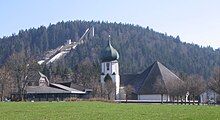
The main industry of the Black Forest is tourism. Black Forest Tourism (Schwarzwald Tourismus) assesses that there are around 140,000 direct full-time jobs in the tourist sector and around 34.8 million tourist overnight stays in 2009.[53]In spring, summer and autumn an extensive network of hiking trails and mountain bike routes enable different groups of people to use the natural region. In winter, it is the various types of winter sport that come to the fore. There are facilities for bothdownhillandNordic skiingin many places.
Tourist attractions[edit]

The most heavily frequented tourist destinations and resorts in the Black Forest are theTitiseeand theSchluchsee.Both lakes offer opportunities for water sports likedivingandwindsurfing.TheMummelseeis a recreational lake and a starting point for a number of hiking trails including theKunstpfad am Mummelsee( "sculpture trail at the Mummelsee" ).[54]TheMurg valley,theKinzig valley,theTriberg Waterfallsand theOpen Air Museum at Vogtsbauernhofare also popular. Lookout mountains include theFeldberg,theBelchen,theKandeland theSchauinslandin the Southern Black Forest; and theHornisgrinde,theSchliffkopf,theHohloh,theMerkurand theTeufelsmühlein the Northern Black Forest. The height differences in the mountains are used in many places forhang glidingandparagliding.
One often visited town isBaden-Badenwith its thermal baths and festival hall. Other thermal baths are found in the spa resorts ofBadenweiler,Bad Herrenalb,Bad Wildbad,Bad Krozingen,Bad LiebenzellandBad Bellingen.From the beginning of the 19th century, the desire for spa and bathing resorts arose in all ofCentral Europebecause of the increasing economic potential, increasing mobility and the use of advertising. TheNeo-renaissancestyleFriedrichsbadand thePalais Thermalare examples for spas built in this era.[55]
Other tourist destinations are the old imperial town ofGengenbach,the former county towns ofWolfach,SchiltachandHaslach im Kinzigtaland the flower and wine village ofSasbachwaldenat the foot of the Hornisgrinde. Picturesque old towns may be visited inAltensteig,Dornstetten,Freiburg im Breisgau,Gernsbach,VillingenandZell am Harmersbach.Baiersbronnis a centre of gastronomic excellence,Freudenstadtis built around the largest market place in Germany.Gersbach's floral displays have won awards as the German Golden Village of 2004 and theEuropean Golden Villageof 2007.
Noted for their fine interiors are the former monastery ofSt. Blasienas well as the abbeys ofSankt Trudpert,St. PeterandSt. Märgen.
Alpirsbach Abbeyand the ruinedHirsau Abbeywere built of red sandstone in the Hirsau style. Another idyllic rural edifice isWittichen AbbeynearSchenkenzell.
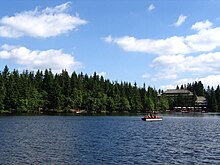
There are well known winter sports areas around the Feldberg, nearTodtnauwith itsFISdownhill ski run ofFahler Lochand inHinterzarten,a centre and talent forge for German ski jumpers. In the Northern Black Forest, the winter-sports areas are concentrated along theBlack Forest High Roadand on the ridge between the Murg and Enz rivers aroundKaltenbronn.
Hiking trails[edit]
The Black Forest has a great number of very varied trails; some of pan-regional significance. TheEuropean long-distance pathE1crosses the Black Forest following the routes of some of the local long-distance paths. Their framework is a network of long-distance paths with main routes and side branches, many of which were laid out in the early 20th century by theBlack Forest Club (Schwarzwaldverein).The best known of these is the challenging West Way (Westweg) with its many steep inclines. After 1950, circular walks were constructed to meet the changing demand, initially from the relatively dense railway network and, later, mainly from locally established hiking car parks. Currently, special, more experience-oriented themed paths are being laid out, such as the Dornstetten Barefoot Park (Barfußpark Dornstetten), the Park of All Senses (Park mit allen Sinnen) inGutach(Black Forest Railway), as well as those designed to bring the walker more directly in contact with nature (e.g. theSchluchtensteig). Roads and wide forest tracks are thus less often used than hitherto.
There are numerous shorter paths suitable for day walks, as well asmountain bikingandcross-country skiingtrails. The total network of tracks amounts to around 23,000 kilometres (14,000 mi), and is maintained and overseen by volunteers of theBlack Forest Club(figures from Bremke, 1999, p. 9), which is the second largest German hiking association. As of 2021, the club counts 65,000 members.[56]
|
|
Museums in the Black Forest[edit]
Culture and crafts[edit]

TheBlack Forest Open Air Museumat the Vogtsbauernhof farm inGutachhas originalBlack Forest housesoffering insights into farming life of the 16th and 17th centuries. The buildings were dismantled at their original sites, the individual pieces numbered and then re-erected to exactly the same plan in the museum. The open-air museum shows the life of 16th and 17th century farmers in the region featuring theVogtsbauernhofwhich dates back to 1612.[57]
TheGerman Clock MuseuminFurtwangengives a comprehensive cross-section of the history of thewatchmakingandclockmakingindustries.
From this early precision engineering a formerly important phonographic industry developed in the 20th century; the history of leisure electronics is presented in theGerman Phono MuseuminSt. Georgen.
TheSchüttesäge MuseuminSchiltachhas information and living history demonstrations covering the themes oflumberingandtimber raftingin the Kinzig valley as well astanning.
TheBlack Forest Costume MuseuminHaslach im Kinzigtaloffers an overview of the traditional costume of the whole of the Black Forest and its peripheral regions. Also located in Haslach: the Hansjakob Museum and the Hansjakob Archive with numerous works of the writer, priest, politician, historian and chronicler,Heinrich Hansjakob.
Nature and science[edit]
TheMiMa Mineralogy and Mathematics MuseuminOberwolfachhouses minerals and mining exhibits from the whole of the Black Forest and links them to mathematical explanations.
Infrastructure[edit]
Road transport[edit]
Several tourist routes run through the Black Forest. Well knownholiday routesare theBlack Forest High Road(B 500) and theGerman Clock Road.[58]
Thanks to its winding country roads, the Black Forest is a popular destination formotorcyclists.This arm of tourism is controversial due to the high number of accidents and the wide-ranging noise pollution[59]and has been restricted through the introduction of speed limits and by placing certain roads out of bounds. For example, since 1984, motorcyclists have been banned from using themountain-racing routeon theSchauinslandduring summer weekends.[60]
Railway transport[edit]

The whole of the Black Forest was once linked byrailway.In the eastern part of the Northern Black Forest by theEnz Valley RailwayfromPforzheimtoBad Wildbad,by theNagold Valley Railwayfrom Pforzheim viaCalwandNagoldtoHorb am Neckar,by theWürttemberg Black Forest RailwayfromStuttgartto Calw and the Gäu Railway from Stuttgart to Freudenstadt or its present-daysection from Eutingen to Freudenstadt.
Many railway lines run from the Rhine Plain up the valleys into the Black Forest: theAlb Valley Railwayruns fromKarlsruhetoBad Herrenalb,theMurg Valley RailwayfromRastatttoFreudenstadt,theAcher Valley RailwayfromAcherntoOttenhöfen im Schwarzwaldand theRench Valley RailwayfromAppenweiertoBad Griesbach.TheBaden Black Forest Railwayhas linkedOffenburgwithKonstanzonLake Constancesince 1873, running viaHausach,Triberg,St. Georgen,VillingenandDonaueschingen.In Hausach theKinzig Valley Railwaybranches off to Freudenstadt, inDenzlingentheElz Valley Railwaypeels off towardsElzach,theHöllental Railwayruns fromFreiburg im Breisgauthrough the Höllental valley to Donaueschingen, theMünstertal RailwayfromBad KrozingentoMünstertal,theKander Valley RailwayfromHaltingennearBaselthrough the Kander valley toKandernand theWiesen Valley RailwayfromBaseltoZell im Wiesental.
TheThree Lakes Railwaybranches off at theTitiseefrom the Höllental Railway and runs to theWindgfällweiherand theSchluchsee.TheWutach Valley Railwayruns along the border between Baden-Württemberg and Switzerland, linkingWaldshut-TiengenwithImmendingenon the Black Forest Railway.
Most of these routes are still busy today, whilst some are popularheritage lines.
Administration[edit]
Since January 2006, the Black Forest Tourist organisation,Schwarzwald Tourismus,whose head office is inFreiburg,has been responsible for the administration of tourism in the 320 municipalities of the region. Hitherto there had been four separate tourist associations.
Points of interest[edit]
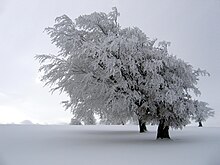
There are many historic towns in the Black Forest. Popular tourist destinations includeBaden-Baden,Freiburg,Calw(the birth town ofHermann Hesse),Gengenbach,Staufen,Schiltach,HaslachandAltensteig.Other popular destinations include such mountains as the Feldberg, theBelchen,theKandel,and the Schauinsland; theTitiseeandSchluchseelakes; theAll Saints Waterfalls;theTriberg Waterfalls,not the highest, but the most famous waterfalls in Germany; and thegorgeof the RiverWutach.
For drivers, the main route through the region is the fastA 5(E35) motorway, but a variety of signposted scenic routes such as theSchwarzwaldhochstraße(60 km (37 mi),Baden-BadentoFreudenstadt), Schwarzwald Tälerstraße (100 km (62 mi), theMurgandKinzigvalleys) or Badische Weinstraße (Baden Wine Street, 160 km (99 mi), a wine route fromBaden-BadentoWeil am Rhein) offers calmer driving along high roads.[61]The last is a picturesque trip starting in the south of the Black Forest going north and includes numerous old wineries and tiny villages. Another, more specialized route is theGerman Clock Route,[62]a circular route that traces thehorologicalhistory of the region.

Due to the rich mining history dating from medieval times (the Black Forest was one of the most important mining regions of Europec. 1100) there are many mines re-opened to the public. Such mines may be visited in the Kinzig valley, the Suggental, the Muenster valley, and around Todtmoos.
The Black Forest was visited on several occasions by CountOtto von Bismarckduring his years as Prussian and later German chancellor (1862–1890). Allegedly, he was especially interested in theTriberg Waterfalls.[63]There is now a monument in Triberg dedicated to Bismarck, who apparently enjoyed the tranquility of the region as an escape from his day-to-day political duties in Berlin.
The Black Forest featured in the philosophical development ofMartin Heidegger.Heidegger wrote and edited some of his philosophical works in a small hut in the Black Forest,[64]and would receive visitors there for walks, including his former pupilHannah Arendt.This hut features explicitly in his essayBuilding, Dwelling, Thinking.[65]His walks in the Black Forest are supposed to have inspired the title of his collection of essaysHolzwege,translated asOff The Beaten Track.[66]
Economy and craftsmanship[edit]
Mining[edit]

Mining developed in the Black Forest due to its ore deposits, which were often lode-shaped. The formation of these deposits (Schauinsland Pit:zinc,lead,about 700–1000 gsilver/ton of lead;baryte,fluorite,less lead and zinc in the Kinzig valley;BiCoNiores nearWittichen,uraniumdiscovered in theKrunkelbach valleynearMenzenschwandbut never officially mined) often used to be linked to the intrusion of Carboniferous granite in the para- and orthogneisses. More recent research has revealed that most of these lode fillings are much younger (TriassictoTertiary). Economic deposits of other minerals included: fluorite in the Northern Black Forest nearPforzheim,baryte in the central region nearFreudenstadt,fluorite along with lead and silver near Wildschapbach, baryte and fluorite in the Rankach valley and near Ohlsbach, in the Southern Black Forest nearTodtnau,Wiedenand Urberg.
Small liquid magmatic deposits of nickel-magnetite gravel innoritewere mined or prospected in the Hotzenwald forest near Horbach andTodtmoos.Strata-bound deposits include iron ores in the Dogger layer of the foothill zone and uranium near Müllenbach/Baden-Baden.Stone coalis only found nearBerghauptenandDiersburg,but was always only of local importance.
Chronology:Stone Agemining ofhaematite(as red pigment) nearSulzburg.By the 5th and 6th centuries B.C.iron orewas being mined by theCeltsin the Northern Black Forest (for example inNeuenbürg). Especially in the Middle Black Forest, but also in the south (for example in theMünster valley) ore mining was already probably taking place in Roman times (miningof silver and lead ore; evidence of this at Sulzburg and possiblyBadenweiler). Until theHigh Middle Agesthe High Black Forest was practically unsettled. In the course of inland colonisation in the Late High Middle Ages even the highlands were cultivated by settlers from the abbeys (St. Peter's,St. Märgen's). In the Late High Middle Ages (from about 1100) mining experienced another boom, especially around Todtnau, in the Münster and Suggen valleys and, later, on theSchauinslandtoo. It is believed that around 800–1,000 miners lived and worked in the Münster valley until the end of the Middle Ages. After the Plague, which afflicted the valley in 1516, theGerman Peasants' War(1524–26) and theThirty Years' War,mining in the region declined until just a few pits remained.
An important mining area was theKinzig valleyand its side valleys. The small mining settlement ofWittichennearSchenkenzellin the upper Kinzig valley had many pits from which miners dugbaryte,cobaltandsilverof many kinds. A circular, geological footpath runs today past the old pits andtips.
Another boom began in the early 18th century after the loss of theAlsaceto France. It lasted until the 19th century. Many pits from this period may be visited today asshow mines;for example the Teufelsgrund Pit (Münstertal), theFinstergrundPit near Wieden, the Hoffnungsstollen ( "Hope Gallery" ) at Todtmoos, the mine in theSchauinsland,the formerly especially silver-richWenzel PitinOberwolfachand Gr.Segen Gottes( "God's Great Blessing" ) inHaslach-Schnellingen.
Non-ferrous metal mining in the Black Forest continued until the middle of the 20th century nearWildschapbachand on the Schauinsland (to 1954); fluorite and baryte are still mined today at theClara Pitin the Rankach valley inOberwolfach.Iron ores of the Dogger formation was worked until the 1970s nearRingsheimand was smelted inKehl.
Compared with theHarzandOre Mountainsthe quantities of silver extracted in the Black Forest were rather modest and reached only about ten percent of that produced in the other silver-mining regions.
There are manyshow minesin the Black Forest. These include: the Frischglück Pit nearNeuenbürg,the Hella Glück Pit nearNeubulach,the Silbergründle Pit nearSeebach,the Himmlich Heer Pit nearHallwangen,the Heilige Drei Könige Pit nearFreudenstadt,theSegen Gottes PitnearHaslach,the Wenzel Pit nearOberwolfach,theCaroline PitnearSexau,the Suggental Silver Mine nearWaldkirch,the Schauinsland Pit nearFreiburg,the Teufelsgrund Pit nearMünstertal,the Finstergrund Pit nearWiedenand the Hoffnungsstollen Pit nearTodtmoos.
Forestry[edit]

For several centuries logs from the Black Forest were rafted down theEnz,Kinzig,Murg,NagoldandRhinerivers for use in theshippingindustry, as constructiontimberand for other purposes. This branch of industry boomed in the 18th century and led to large-scale clearances. As most of the long, straight pine logs were transported downriver for shipbuilding in theNetherlands,they were referred to as "Dutchmen". The logs were used in the Netherlands, above all, aspilesfor house construction in the sandy and wet ground. Even today in Amsterdam large numbers of historic building are built on these posts and the reforestation of the Black Forest with sprucemonoculturestestifies to the destruction of the originalmixed forest.With the expansion of the railway and road network as alternative transportation, rafting largely came to an end in the late 19th century.
Today, loggers harvest fir trees—especially very tall and branchless ones—mainly to ship to Japan. The global advertising impact ofExpo 2000fuelled a resurgence of timber exports. The importance of the timber resources of the Black Forest has also increased sharply recently due to the increasing demand forwood pelletsfor heating.
Glass-making, charcoal-burning and potash-mining[edit]
The timber resources of the Black Forest provided the basis for other sectors of the economy that have now largely disappeared.Charcoal burners(Köhler) built their wood piles (Meiler) in the woods and produced charcoal, which, like the products of thepotashboilers—further processedinter aliafor theglassmakingindustry. The Black Forest supplied raw materials and energy for the manufacture offorest glass.This is evidenced today by a number ofglassblowinghouses e.g. in the Hoellental in Todtnau andWolfachand the Forest Glass Centre inGersbach (Schopfheim),which is open to visitors.
Precision-engineering, clock and jewellery manufacture[edit]

In the relatively inaccessible Black Forest valleys,industrializationdid not arrive until late in the day. In winter, manyfarmersmade woodencuckoo clocksto supplement their income. This developed in the 19th century into theprecision engineeringand watch industry, which boomed with the arrival of the railway in many of the Black Forest valleys. The initial disadvantage of their remote location, which led to the development of precision-engineered wooden handicrafts, became a competitive advantage because of their access to raw materials: timber from the forest and metal from the mines. As part of a structural support programme the Baden State Government founded the first clockmaking school in 1850 inFurtwangento ensure that small artisans were given good training and thus better sales opportunities. Due to the increasing demand for mechanical devices, large companies such asJunghansandKienzlebecame established. In the 20th century, the production of consumer electronics was developed by companies such asSABA,DualandBecker.In the 1970s, the industry declined due to Far Eastern competition. Nevertheless, the Black Forest remains a centre for the metalworking industry and is home to many high-tech companies.
Since the start of industrialisation there have been numerous firms inPforzheimthat manufacture jewellery and work with precious metals and stones. There is also agoldsmith's school in Pforzheim.
Hydropower[edit]


Due to the large amounts of precipitation and elevation changes the Black Forest has significanthydropowerpotential. This was used until the 19th century especially for operating numerousmills,includingsawmillsandhammer millsand was one of the local factors in the industrialization of some Black Forest valleys.
Since the 20th century, the Black Forest has seen the large-scale generation of electrical power usingrun-of-the-river power plantsandpumped storage power stations.From 1914 to 1926, the Rudolf Fettweis Company was established in the Murg valley in the Northern Black Forest with the construction of theSchwarzenbach Dam.In 1932, theSchluchseereservoir, with its new dam, became the upper basin of a pumped-storage power plant. In 2013 the association of the Southern Black Forest'sSchluchseewerkowned five power plants with 14 storage tanks. At theHornberg Basintopographical conditions allow an average head of water of 625 m to drive the turbines before it flows into theWehra Reservoir.
In the 21st century, in the wake of theRenewable Energy Sources Act,numerous smaller run-of-the-river power stations were re-opened or newly constructed.
Notable people and residents[edit]
- Hans Jakob Christoffel von Grimmelshausen(1621/22–1676), German novelist; in 1665–67, he kept an inn in Gaisbach in the Black Forest while writing his famouspicaresque novelSimplicius Simplicissimus(1669)
- Hans Thoma,born inBernau(1839–1924), German painter
- Hermann Hesse,born inCalw(1877–1962), German poet and novelist
- Jürgen Klopp,football manager, who grew up in village ofGlatten
- Martin Heidegger,German philosopher, who spent much of his time inTodtnauberg,where he wrote most ofBeing and Time.
Gallery[edit]
-
TheFeldberg
-
View from theBelchentowards the Alps
-
Cattle nearSimonswald
-
TheTitisee,popular year-round
-
The RiverKinzigpassing through the Black Forest
-
TheMummelsee
-
The Black Forest is known for its nativeclockmakers
-
Traditional farmhouse of the Black Forest
-
Paragliding aboveBaden-Baden
-
The formerGraf-Eberhard-Bad(now:Palais Thermal) inBad Wildbad
See also[edit]
- Hercynian Forest(historic)
- Schwarzwaldverein(Black Forest Association)
- German Clock Museum
- Black Forest gateau
- Black Forest ham
Notes[edit]
- ^These severe storms or cyclones are commonly known as hurricanes even though they are not true tropical hurricanes.
References[edit]
- ^ab"Black Forest | Description, Map, & Facts".Encyclopedia Britannica.Archivedfrom the original on 20 December 2020.Retrieved17 January2021.
- ^Chilcoat, Loretta and Rueben Acciano,Western Europe,Lonely Planet: 2005, p. 480.
- ^"Die Wirtschaft im Schwarzwald: Tourismus, Holzwirtschaft und anderes".schwarzwald-reiseinfo.de.Archivedfrom the original on 11 April 2021.Retrieved4 January2021.
- ^"Gersbacher Barockschanze".schwarzwald-tourismus.info(in German).Archivedfrom the original on 22 January 2021.Retrieved17 January2021.
- ^Tabula Peutingeriana;Ammianus Marcellinus21, 8, 2;
- ^"Schwedenschanze".schwarzwald-tourismus.info(in German).Archivedfrom the original on 1 June 2022.Retrieved17 January2021.
- ^"Schwarzwald Röschenschanze".schwarzwald-informationen.de.Archivedfrom the original on 22 January 2021.Retrieved17 January2021.
- ^Information Service for Agriculture, Nutrition and Regional PlanningArchived10 February 2012 at theWayback Machineat the Ministry for Regional Planning, Nutrition and Consumer Protection in Baden-Württemberg
- ^Robert Gradmann:Süddeutschland.Engelhorn, Stuttgart 1931. Reprint:Wissenschaftliche BuchgesellschaftDarmstadt,ISBN3-534-00124-9.Vol. 2:The einzelnen Landschaften,p. 85.
- ^c.f.Das Land Baden-Württemberg – Amtliche Beschreibung nach Kreisen und Gemeinden.Vol. 1:Allgemeiner Teil.Kohlhammer Verlag,Stuttgart 1974,ISBN3-17-001835-3,p. 32, or: Christoph Borcherdt (ed.):Geographische Landeskunde von Baden-Württemberg.3rd edition, Kohlhammer, Stuttgart, 1993, pp. 169 f.
- ^Rudolf Metz:Zur naturräumlichen Gliederung des SchwarzwaldsIn:Alemannisches Institut(ed.): Alemannisches Jahrbuch 1959, Schauenburg, Lahr 1959, pp. 1–33
- ^Emil Meynen, Josef Schmithüsen:Handbuch der naturräumlichen Gliederung Deutschlands.Bundesanstalt für Landeskunde, Remagen/Bad Godesberg 1953–1962 (nine instalments in eight books, updated 1:1,000,000 map with major units, 1960).
- ^Emil Meynen, Josef Schmithüsen (editors:Handbuch der naturräumlichen Gliederung Deutschlands.Bundesanstalt für Landeskunde, Remagen/Bad Godesberg, 1953–1962 (9 issues in 8 books, updated map, 1:1,000,000 with major units, 1960).
- ^Thomas Breunig:Überarbeitung der Naturräumlichen Gliederung Baden-Württembergs auf Ebene der naturräumlichen Haupteinheiten.Archived19 December 2014 at theWayback MachineIn: Naturschutz-Info 1998, Heft 1
- ^Major natural region units,Baden-Württemberg State Office for the Environment, Survey and Conservation (Landesanstalt für Umwelt, Messungen und Naturschutz Baden-Württemberg) (pdf, 3.1 MB)
- ^Natural region fact file Schwarzwald-Randplatten (150)–LUBW(pdf, 9,9 MB)
- ^Natural region fact file Grindenschwarzwald und Enzhöhen (151)–LUBW(pdf, 8,9 MB)
- ^Natural region fact file Nördlicher Talschwarzwald (152)–LUBW(pdf, 9,0 MB)
- ^Natural region fact file Mittlerer Schwarzwald (153)–LUBW(pdf, 9,6 MB)
- ^Natural region fact file Südöstlicher Schwarzwald (154)–LUBW(pdf, 6,8 MB)
- ^Natural region fact file Hochschwarzwald (155)–LUBW(pdf, 10,1 MB)
- ^Map servicesof theFederal Agency for Nature Conservation
- ^Harris, Stuart A. (1968). "Treppen concept (penck)".Geomorphology.Encyclopedia of Earth Science.ISBN978-3-540-31060-0.
- ^Spreitzer, H. (1951). "Die Piedmonttreppen in der regionalen Geomorphologie".Erdkunde(in German).5(4): 294–305.JSTOR25635740.
- ^SchwarzwaldwichtelArchived23 August 2017 at theWayback Machineat trachten-winkler. Retrieved 23 August 2017.
- ^SchwarzwaldwichtelArchived23 August 2017 at theWayback Machineat schwarzwald-laden.de. Retrieved 23 August 2017.
- ^"Schwarzwald-Geschichten".onlinesammlung.freiburg.de(in German).Archivedfrom the original on 12 June 2021.Retrieved3 January2021.
- ^"Gutach: Bollenhutmacherin gibt Einblicke in ihr Handwerk".Schwarzwälder Bote(in German).Archivedfrom the original on 26 January 2021.Retrieved3 January2021.
- ^Brigitte Heck:Ein Hut macht Karriere..In: Badisches Landesmuseum Karlsruhe (publ.):Baden! 900 Jahre – Geschichten eines Landes.Info-Verlag, Karlsruhe 2012,ISBN978-3-937345-56-7,p. 256 (Katalog zur Großen Landesausstellung)
- ^"Glasmuseum".Dorotheenhütte Wolfach/Schwarzwald(in German).Archivedfrom the original on 6 December 2020.Retrieved3 January2021.
- ^"Gemeinde Grainet – Wanderglashütten".grainet.de.Archivedfrom the original on 26 January 2021.Retrieved3 January2021.
- ^"Die Wirtschaft im Schwarzwald".Schwarzwaldportal(in German). 10 October 2008.Archivedfrom the original on 7 January 2021.Retrieved4 January2021.
- ^"Possibly Germany's most famous cake: Schwarzwalder Kirschtorte (Black Forest Cake)".European Cuisines.Archivedfrom the original on 1 February 2018.Retrieved24 December2015.
- ^Michelin RestaurantsArchived23 June 2011 at theWayback Machine.Via Michelin. Retrieved 18 June 2011
- ^"TheArchived21 June 2011 at theWayback MachineMichelin Guideand the Zumkeller Chefs ". Schwarzwald Hotel Adler. Retrieved 18 June 2011
- ^"80.000 Besucher bestaunen Fasnetmendig-Umzug zum Rosenmontag in Freiburg".baden.fm(in German). 24 February 2020.Archivedfrom the original on 7 January 2021.Retrieved4 January2021.
- ^abCego – RegelnArchived16 July 2020 at theWayback Machineat cego.de. Retrieved 17 May 2020.
- ^abVermutliche HerkunftArchived8 December 2020 at theWayback Machineat cego-online.de. Retrieved 17 May 2020.
- ^CegoArchived27 March 2020 at theWayback Machineat pagat. Retrieved 17 May 2020.
- ^Cego – ein altes Kartenspiel, das eine Renaissance erlebtArchived9 October 2020 at theWayback Machineat schwarzwaldregion-freiburg.de. Retrieved 17 May 2020.
- ^e.V, VDN-Verband Deutscher Naturparke."Aufgaben & Ziele".naturparke.de(in German).Archivedfrom the original on 2 December 2020.Retrieved3 January2021.
- ^"BfN: National Parks".bfn.de.Archivedfrom the original on 24 March 2020.Retrieved3 January2021.
- ^"Naturpark Südschwarzwald – Allgemeines".naturpark-suedschwarzwald.de.Archivedfrom the original on 9 January 2021.Retrieved3 January2021.
- ^"Naturpark Schwarzwald Mitte/Nord".schwarzwald-tourismus.info(in German).Archivedfrom the original on 23 January 2021.Retrieved3 January2021.
- ^"Schwarzwald Nationalpark: Nationalpark".nationalpark-schwarzwald.de.Archivedfrom the original on 18 January 2021.Retrieved3 January2021.
- ^Enjoy nature with all the senses / Nature / Home / Inhalte – Schwarzwald Tourismus GmbH
- ^"Schöder's Biohof – HINTERWÄLDER RIND".510173769.swh.strato-hosting.eu(in German).Archivedfrom the original on 26 January 2021.Retrieved3 January2021.
- ^Lamparski, 1985
- ^"Home".Black Forest Stud.Archivedfrom the original on 6 May 2021.Retrieved3 January2021.
- ^Zeitung, Badische (26 January 2020)."Dem Auerhuhn fehlt im Schwarzwald der Lebensraum – Südwest – Badische Zeitung".badische-zeitung.de(in German).Archivedfrom the original on 18 May 2021.Retrieved3 January2021.
- ^Liehl, Ekkehard; Sick, Wolf Dieter, eds. (1984), "Der Schwarzwald. Beiträge zur Landeskunde",Veröffentlichung des Alemannischen Instituts Freiburg I. Br.(in German), vol. 47 (3 ed.), Bühl: Konkordia, p. 70,ISBN3-7826-0047-9
- ^LUBW,Deutscher Wetterdienst:Klimaatlas Baden-Württemberg, Jahresniederschläge 1971–2000:KartenbeschreibungArchived20 May 2008 at theWayback Machine,KarteArchived11 November 2013 at theWayback Machine,retrieved 3 September 2013
- ^Including private accommodation and visitors by relatives and friends.Schwarzwald Tourismus GmbH:Tourismusentwicklung im Schwarzwald 2009Archived10 October 2012 at theWayback Machine,retrieved 12 October 2011.
- ^muellerwerbung_wp."Kunstpfad".Erlebniswelt Mummelsee(in German).Archivedfrom the original on 28 September 2020.Retrieved21 September2020.
- ^Bachmann, Günther (1996).Denkmalpflege in Baden-Württemberg.Baden-Württemberg: Nachrichtenblatt des Landesdenkmalamtes. pp. 47–56.
- ^"Der Schwarzwaldverein".schwarzwaldverein.de.Archivedfrom the original on 22 January 2021.Retrieved17 January2021.
- ^"Open Air Museum Vogtsbauernhof – Vogtsbauernhof".Open Air Museum Vogtsbauernhof Gutach.Retrieved29 November2020.[permanent dead link]
- ^Parallelus."On the trail of the Black Forest Cuckooclock » Black Forest Clock Association".Archivedfrom the original on 8 May 2021.Retrieved1 September2020.
- ^Baden-Württemberg: Landesregierung will Motorradlärm eindämmen.Archived1 June 2022 at theWayback MachineIn:Spiegel Onlinedate 24 July 2012
- ^Schauinsland: Motorradfahrer ignorieren Fahrverbot – Radler in Angst.Archived2 April 2015 at theWayback MachineIn:Badische Zeitungdated 28 June 2010
- ^"The complete guide to The Black Forest".The Independent.19 March 2014. Archived fromthe originalon 8 March 2009.Retrieved9 August2014.
- ^Apropos Werbung, Telefon 07721-98770."German Clock Route Location".Deutsche Uhrenstrasse.Archivedfrom the original on 9 February 2006.Retrieved9 August2014.
{{cite web}}:CS1 maint: numeric names: authors list (link) - ^Ken Barnes (2007).A Rough Passage, Volume II: Memories of Empire.The Radcliffe Press.ISBN9781845112646.Archivedfrom the original on 1 June 2022.Retrieved9 August2014.
- ^Sharr, Adam (27 October 2006).Heidegger's Hut | The MIT Press.Mitpress.mit.edu.ISBN9780262195515.Archivedfrom the original on 10 May 2015.Retrieved24 December2015.
- ^"Heidegger's Aesthetics (Stanford Encyclopedia of Philosophy)".Plato.stanford.edu.Archivedfrom the original on 11 December 2015.Retrieved24 December2015.
- ^Heidegger, Martin (2002).Heidegger: Off the Beaten Track – Martin Heidegger, Julian Young, Kenneth Haynes.ISBN9780521805070.Archivedfrom the original on 21 December 2019.Retrieved24 August2017.
Bibliography[edit]
Geography[edit]
- Hartwig Haubrich; Wolfgang Hug; Herbert Lange (1991),Das große Buch vom Schwarzwald(in German), Stuttgart: Theiss,ISBN3-8062-0819-0.
- Ekkehard Liehl, Wolf Dieter Sick, ed. (1989), "Der Schwarzwald. Beiträge zur Landeskunde",Veröffentlichung des Alemannischen Instituts Freiburg I. Br.(in German), vol. 47 (4. ed.), Bühl: Konkordia,ISBN3-7826-0047-9.
- Kurt Klein (1988), "Verborgener Schwarzwald. Unbekanntes aus Volkskunde und Geschichte",Edition Morstadt(in German), vol. Bd. 18, Kehl, Strasbourg, Basel: Morstadt,ISBN3-88571-172-9.
- Max Scheifele (2004),Aus der Waldgeschichte des Schwarzwaldes. Die Trift von Brenn- und Kohlholz. Wenn Grenzsteine reden(in German), Stuttgart: DRW-Verlag,ISBN3-87181-010-X.
- Horst Friedrich Vorwerk (Text), Erich Spiegelhalter (Abb.) (1992),Der Schwarzwald. Eine deutsche Kulturlandschaft in Geschichte und Gegenwart(in German), Freiburg: Herder,ISBN3-451-22658-8.
Economy, geology and mining[edit]
- Michael Bliedtner, Manfred Martin (1986),Erz- und Minerallagerstätten des Mittleren Schwarzwaldes(in German), Freiburg im Breisgau: Geologisches Landesamt Baden-Württemberg,ISBN978-88-12-65452-9.
- Eberhard Gothein:Wirtschaftsgeschichte des Schwarzwaldes und der angrenzenden Landschaften. Erster Band: Städte- und Gewerbegeschichte,Verlag Karl J. Trübner, Strassburg 1892 (digitalised).
- Gregor Markl, Sönke Lorenz, ed. (2004),Silber, Kupfer, Kobalt. Bergbau im Schwarzwald(in German), Filderstadt: Markstein,ISBN3-935129-10-6.
- Georg Sawatzki, Horst Peter Hann (2003), "Badenweiler-Lenzkirch-Zone (Südschwarzwald): Erläuterungen mit Hinweisen für Exkursionen",Geologische Karte von Baden-Württemberg 1:50000(in German), Freiburg im Breisgau: Landesamt für Geologie, Rohstoffe und Bergbau Baden-Württemberg.
- Wolfgang Werner, Volker Dennert (2004),Lagerstätten und Bergbau im Schwarzwald(in German), Freiburg im Breisgau: Landesamt für Geologie, Rohstoffe und Bergbau Baden-Württemberg.
Art history[edit]
- Richard Schmidt:Schwarzwald(Deutsche Lande – Deutsche Kunst). Munich/Berlin, 1965.
Nature[edit]
- Adolf Hanle:Nordschwarzwald(Meyers Naturführer). Mannheim/Vienna/Zurich, 1989.
- Adolf Hanle:Südschwarzwald(Meyers Naturführer). Mannheim/Vienna/Zurich, 1989.
- Ulrike Klugmann (Hrsg.):Südschwarzwald, Feldberg und Wutachschlucht(Naturmagazin Draußen). Hamburg, 1983.
- Hans-Peter Schaub:Der Schwarzwald. Naturvielfalt in einer alten Kulturlandschaft.Mannheim, 2001.
Fiction[edit]
- Jürgen Lodemann (ed.):Schwarzwaldgeschichten.Klöpfer & Mayer, Tübingen, 2007,ISBN978-3-940086-04-4.
- Herbert Schnierle-Lutz (ed.):Schwarzwald-Lesebuch. Geschichten aus 6 Jahrhunderten mit zahlreichen Bildern,224 pages, Hohenheim Verlag, Stuttgart, 2011,ISBN978-3-89850-213-9.
General[edit]
- Barnes, K. J. (2007).A Rough Passage: Memories of an Empire
- Bremke, N. (1999).Schwarzwald quer.Karlsruhe: Braun.ISBN3-7650-8228-7.
- Käflein, Achim (photographs); Huber, Alexander (German text); Freund, BethAnne (English translation) (2012).Schwarzwald: Natur und Landschaft.edition-kaeflein.de. p. 228.ISBN978-3-940788-16-0.
- Lamparski, F. (1985). Der Einfluß der Regenwurmart Lumbricus badensis auf Waldböden im Südschwarzwald.Schriftenreihe des Institut für Bodenkunde und Waldernährungslehre der Albert-Ludwigs-Universität Freiburg i. Br., 15.ISSN0344-2691.English summary
External links[edit]
- .Encyclopædia Britannica.Vol. 4 (11th ed.). 1911.
- SchwarzwaldatCurlie





